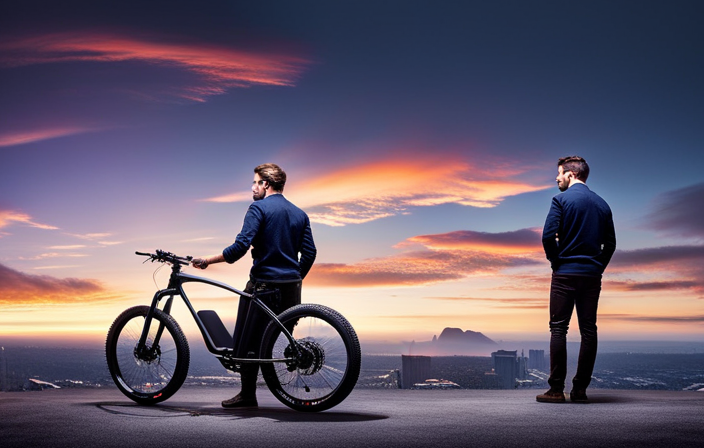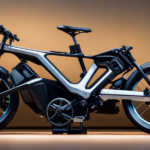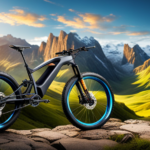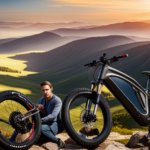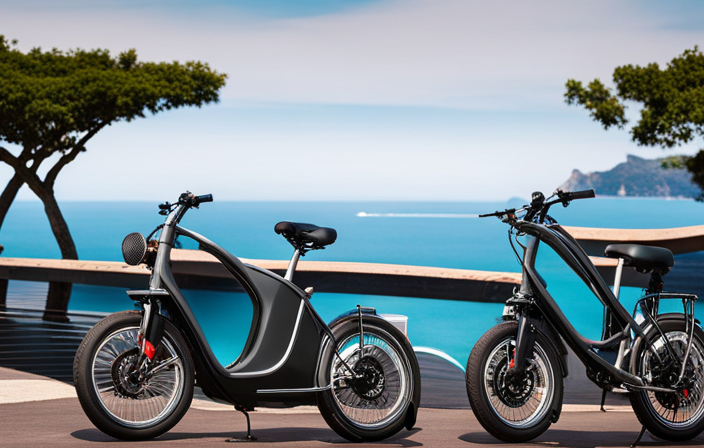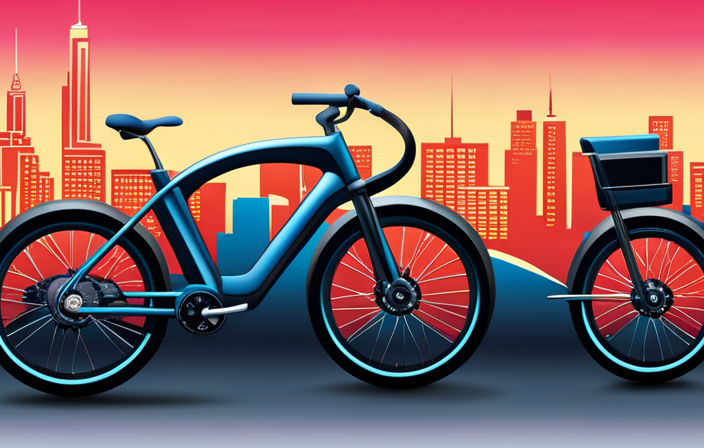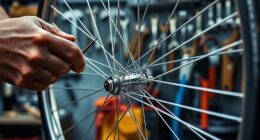I’ve always loved the thrill of mountain biking, but lately, I’ve been wanting to take it up a notch. That’s when I discovered the incredible world of electric bikes.
Imagine effortlessly gliding up those steep inclines and conquering challenging terrains with ease. In this article, I’ll guide you through the process of transforming your trusty mountain bike into an electric powerhouse.
We’ll cover everything from assessing compatibility to installing the conversion kit, so you can enjoy the exhilarating benefits of your very own electric mountain bike.
Let’s get started!
Key Takeaways
- Increased power and speed
- Easier uphill climbs
- Switch between motor-assisted and manual modes
- Enjoyable riding experience
Assess Your Bike’s Compatibility
Before you begin, make sure your bike’s frame and components are compatible with electric bike conversion. Evaluating compatibility is essential to determine the suitability of your mountain bike for the conversion process.
Start by checking the frame material; aluminum or steel frames are usually ideal for conversions due to their durability.
Next, examine the fork and rear dropouts to ensure they can accommodate the additional weight and torque of an electric motor.
Check the bottom bracket shell for clearance and compatibility with the motor and battery.
Assess the brake system to determine if it can handle the increased speed and weight of an electric bike.
Additionally, consider the wheel size and tire clearance, as electric bike components may require specific specifications.
Once you have evaluated compatibility, you can move on to gathering the necessary tools and equipment for the conversion process.
Gather the Necessary Tools and Equipment
Make sure you’ve got all the necessary tools and equipment before starting. Choosing the right battery is crucial for a successful electric bike conversion. You want a battery that is powerful enough to provide the desired range and performance. Look for a lithium-ion battery with a high capacity and voltage. Proper wiring and connection are essential to ensure the safe and efficient operation of your electric bike. Use the table below as a guide to help you gather the necessary tools and equipment for this project:
| Tools | Equipment | Accessories |
|---|---|---|
| Wrench set | Electric motor | Battery charger |
| Screwdriver set | Battery | Wire connectors |
| Pliers | Controller | Cable ties |
| Wire cutter | Throttle | Heat shrink tubing |
| Electrical tape | Pedal assist sensor | Velcro straps |
| Multimeter |
Choose the Right Electric Bike Conversion Kit
Now let’s find the perfect electric bike conversion kit for you.
When it comes to choosing the right electric bike conversion kit, there are a few key factors to consider. Here are some important points to keep in mind:
-
Motor Power: Compare the different electric bike conversion kits based on the power of the motor they offer. Higher power means more speed and better performance.
-
Battery Capacity: Look for conversion kits that come with batteries that have a sufficient capacity to meet your riding needs. Consider factors like range and charging time.
-
Compatibility: Ensure that the conversion kit you choose is compatible with your specific bike model and size.
By comparing different electric bike conversion kits based on these factors, you can make an informed decision and select the kit that best suits your needs.
Now, let’s move on to preparing your bike for the conversion by following a few simple steps.
Prepare Your Bike for the Conversion
Before starting the conversion process, it’s crucial to prepare the bike properly.
First, I clean and inspect the bike thoroughly to ensure there are no damages or issues that may affect the conversion.
Next, I remove any unnecessary parts, such as racks or additional accessories, to lighten the overall weight and create more space for the conversion kit components.
Clean and Inspect the Bike
First, it’s important to thoroughly clean and inspect your bike before beginning the conversion process. Cleaning techniques are essential to ensure a smooth and successful conversion.
Start by removing any dirt, mud, or grease using a mild detergent and water. Pay close attention to hard-to-reach areas like the chain, gears, and brakes. Use a brush or toothbrush to scrub away stubborn grime.
Once clean, inspect your bike using an inspection checklist. Check the frame for any cracks or damage, ensuring it is sturdy enough to handle the added weight of the electric components. Examine the brakes, tires, and suspension system for any wear or defects. Don’t forget to inspect the electrical connections and wiring.
Once your bike is clean and inspected, you can confidently move on to the next section and remove unnecessary parts.
Remove Unnecessary Parts
To begin, you’ll want to take off any unnecessary components from the bike. This step is crucial in order to make room for the new electric components. Here’s what you need to do:
-
Remove the front derailleur: Since you’ll be using an electric motor, you won’t need the front derailleur anymore. Simply loosen the bolts and slide it off.
-
Take off the chainrings: Upgrading the suspension on your electric bike requires removing the chainrings. Use a chainring tool to unscrew them from the crankset.
-
Remove the rear derailleur: With the electric motor providing assistance, you won’t need the rear derailleur either. Unscrew the bolts and carefully detach it from the derailleur hanger.
By removing these unnecessary components, you’ll make space for the new electric components.
Now, let’s move on to checking the bike’s frame and components to ensure everything is in good condition.
Check the Bike’s Frame and Components
After removing unnecessary parts from my mountain bike, it was time to move on to the next step of the conversion process: checking the bike’s frame and components. This is an important step to ensure that the bike is compatible with the electric conversion kit and to inspect the overall condition of the bike.
To assess frame compatibility, I carefully examined the frame’s construction and geometry. I made sure that there was enough space to accommodate the conversion components without any interference or structural issues. Additionally, I checked for any signs of damage or cracks that could affect the bike’s performance and safety.
Next, I inspected the bike’s components, such as the brakes, gears, and wheels. I made sure that everything was in proper working condition and adjusted as necessary. This step is crucial to ensure a smooth and reliable electric biking experience.
With the frame and components assessed and inspected, it was time to proceed to the next section: installing the electric bike conversion kit.
Install the Electric Bike Conversion Kit
Once you’ve gathered all the necessary tools and components, it’s time to start installing the electric bike conversion kit.
Here’s a step-by-step guide to help you through the electric bike conversion process:
-
Begin by removing the rear wheel of your mountain bike and attaching the electric motor to the frame. Make sure to align it properly and tighten the bolts securely.
-
Connect the motor to the battery pack using the provided wiring harness. Double-check the connections to ensure everything is properly attached.
-
The benefits of electric mountain biking are numerous. With the electric bike conversion, you’ll experience increased power and speed, making uphill climbs easier and more enjoyable. Plus, you can switch between motor-assisted and manual modes, giving you complete control over your ride.
With the electric bike kit installed, it’s time to test and adjust your new electric bike for optimal performance.
Test and Adjust the Electric Bike Conversion
Before taking your newly converted electric bike on a ride, it’s crucial to test and adjust various components to ensure optimal performance.
Firstly, check the motor and battery performance by assessing the power output and battery life.
Next, test the brakes and gears to ensure smooth and accurate functionality during rides.
Check the Motor and Battery Performance
To ensure optimal performance, make sure to check the motor and battery of your mountain bike before converting it into an electric bike. Here are some important steps to follow for motor and battery maintenance and troubleshooting common issues:
-
Inspect the motor: Check for any loose connections or damaged wires. Ensure that the motor is securely attached to the bike frame.
-
Test the battery: Charge your battery fully and check for any signs of damage, such as leaks or swelling. Verify that the battery connections are tight and secure.
-
Check the wiring: Examine the wiring for any frayed or exposed areas. Make sure all connections are properly insulated and protected.
-
Troubleshoot common issues: If your motor or battery is not functioning properly, consult the manufacturer’s manual or reach out to a professional for assistance.
By thoroughly checking the motor and battery, you can avoid potential issues and ensure a smooth conversion process.
Now, let’s move on to testing the brakes and gears.
Test the Brakes and Gears
Now, it’s important to check if the brakes and gears on your bike are working properly.
To ensure a safe and efficient ride, start by checking the brake performance. Squeeze the brake levers and observe if they engage smoothly and provide sufficient stopping power. If the brake pads are worn out or the braking feels weak, it’s time for replacement.
Next, test the gear functionality. Shift through each gear while pedaling and pay attention to any hesitation or skipping. Ensure that the chain moves smoothly between the gears and that there are no unusual noises. If you encounter any issues, consider adjusting the derailleur or replacing worn-out components.
Make any Necessary Adjustments
After testing the brakes and gears, make sure to address any necessary adjustments promptly. Making necessary modifications to your electric mountain bike is crucial to ensure optimal performance and safety. Here are some key adjustments to consider:
-
Adjusting the suspension: Fine-tuning the suspension system is essential for a smooth and comfortable ride. You can adjust the air pressure, rebound, and compression settings to match your riding style and terrain.
-
Checking tire pressure: Maintaining the right tire pressure is vital for a balanced and controlled ride. Make sure to check and adjust the tire pressure regularly to prevent flats and improve traction.
-
Aligning the handlebars and seat: Proper alignment of the handlebars and seat is essential for a comfortable riding position and better control. Ensure that they are adjusted to the correct height and angle.
By making these necessary adjustments, you can optimize your electric mountain bike’s performance and ride quality.
Now, let’s move on to learning how to ride and control your electric mountain bike seamlessly.
Learn to Ride and Control Your Electric Mountain Bike
Once you’ve mastered riding a regular mountain bike, it’s time to learn how to ride and control your new electric mountain bike. Riding an electric mountain bike requires a slightly different approach and understanding of its capabilities. Here are some riding techniques and safety tips to help you get started:
| Riding Techniques | Safety Tips | Equipment Check |
|---|---|---|
| Maintain a steady speed to optimize battery life | Always wear a helmet | Check the brakes and tires for proper functioning |
| Use the pedal-assist feature to tackle steep inclines | Observe traffic rules and signals | Ensure the battery is securely attached |
| Practice smooth acceleration and deceleration | Use hand signals when turning | Check the lights and reflectors for visibility |
| Be aware of the bike’s weight and balance when maneuvering | Ride defensively and anticipate obstacles | Inspect the chain and gears for wear and tear |
| Practice braking techniques to control speed | Ride in well-lit areas at night | Check the suspension and adjust if needed |
Maintain and Care for Your Electric Mountain Bike
To keep your electric mountain bike in top condition, it’s important to regularly inspect and maintain its components. Proper electric bike maintenance is crucial for ensuring optimal performance and longevity. Here are three essential steps to help you troubleshoot common issues and keep your electric bike running smoothly:
-
Battery Maintenance:
Regularly check your battery’s charge level and ensure it is properly connected. Clean the battery terminals to prevent corrosion and maintain a good electrical connection. Follow the manufacturer’s guidelines for charging and storing your battery to maximize its lifespan. -
Drive System Inspection:
Inspect your bike’s drive system, including the motor, chain, and gears. Look for any signs of wear or damage and make necessary adjustments or replacements. Regularly lubricate the chain and gears to reduce friction and extend their lifespan. -
Brake and Tire Check:
Ensure your brakes are functioning properly and adjust them if necessary. Check the tire pressure and tread depth regularly to ensure optimal grip and safety on various terrains.
By following these maintenance steps, you can keep your electric mountain bike in excellent condition.
Now, let’s move on to the importance of observing safety precautions and regulations.
Observe Safety Precautions and Regulations
Make sure you follow all safety precautions and regulations when using your electric mountain bike. Safety gear is essential to protect yourself while riding. Always wear a helmet to safeguard your head from potential injuries. Additionally, knee and elbow pads can provide extra protection in case of falls or accidents.
It is also crucial to be aware of the legal requirements for using an electric mountain bike. Check your local regulations to ensure that your bike meets all the necessary specifications, such as speed limits or age restrictions.
Enjoy the Benefits of Your Electric Mountain Bike
You can fully experience the advantages of your e-bike by exploring new trails and enjoying the thrill of off-road riding. Electric mountain bikes offer a range of benefits that enhance your riding experience. Here are some tips for maximizing your electric bike’s performance:
-
Extended Range: With an electric bike, you can cover longer distances without feeling exhausted. The motor assists your pedaling, allowing you to conquer challenging terrains and explore new trails effortlessly.
-
Improved Climbing: Electric mountain bikes provide extra power when climbing steep hills. The motor helps you maintain a consistent speed and tackle challenging ascents with ease, making your off-road adventures even more enjoyable.
-
Enhanced Control: Electric bikes often come equipped with advanced features like adjustable suspension and responsive brakes, enhancing your control over the bike. These features improve your handling on rough terrain, giving you a smoother and safer ride.
Frequently Asked Questions
How long does it usually take to complete the electric bike conversion process?
The average conversion time for turning a mountain bike into an electric bike varies depending on the complexity of the conversion and the individual’s experience. It typically ranges from a few hours to a few days. Cost estimation also depends on the components and accessories chosen.
Can I still use my mountain bike as a regular bike after the conversion?
Yes, you can still use your mountain bike as a regular bike after the conversion. This means you can enjoy off-road adventures using your mountain bike, while also benefiting from the convenience of an electric bike for commuting.
Will the electric bike conversion affect the weight and balance of my mountain bike?
Yes, the electric bike conversion will affect the weight and balance of your mountain bike. The addition of the electric motor and battery will increase the overall weight, potentially altering the bike’s balance and handling.
Are there any specific maintenance requirements for an electric mountain bike?
Maintaining an electric mountain bike requires attention to battery and motor maintenance. Regularly check and charge the battery, while ensuring proper motor lubrication. These essential tasks will keep your ride smooth and your adventures electrifying.
Are there any legal restrictions or regulations I need to be aware of when riding an electric mountain bike?
When riding electric mountain bikes, it is important to be aware of legal restrictions and regulations. These can vary depending on your location, but may include speed limits, age restrictions, and the requirement of a helmet or license.
Conclusion
As I wrap up this guide on how to turn your mountain bike into an electric bike, I can’t help but feel like a trailblazer in the world of cycling.
It’s truly amazing how technology has evolved to give us the power to transform our beloved bikes into electrifying rides.
With the right conversion kit and a little know-how, you can experience the thrill of effortless speed and power on your favorite trails.
So go ahead, embrace the future and electrify your ride.
Happy cycling!
